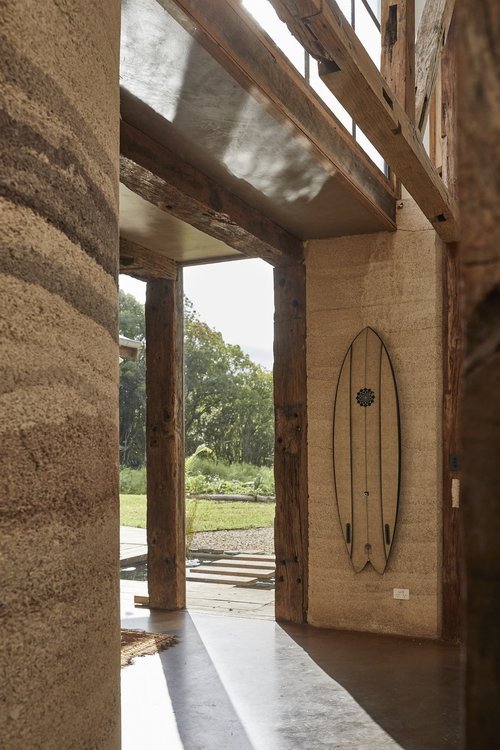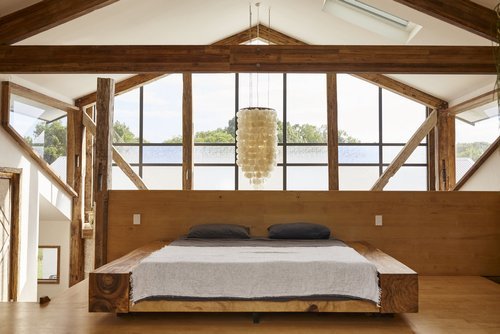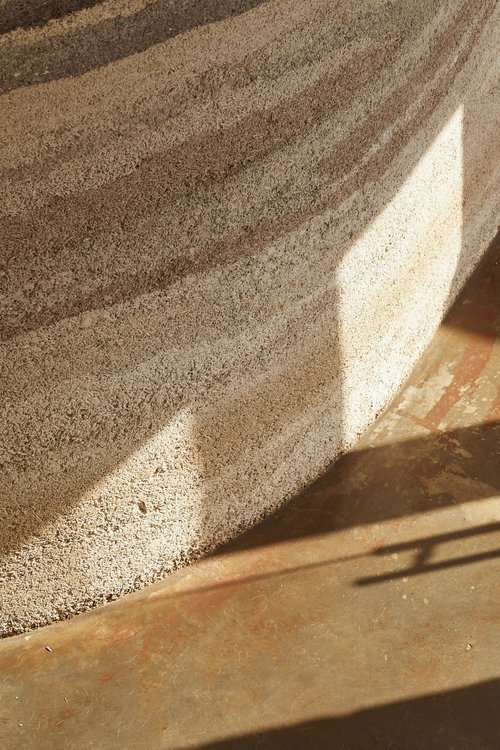
HEMP HABITAT BYRON HINTERLAND
Home Grown in the Byron Hinterland, Hemp Habitat is an R&D practice by Balanced Earth co-founder Luke Wrencher, culminating his life’s work of conscious building and artistic expression. The result is an off-grid, natural home formed from reclaimed timbers and 65 tonnes of hempcrete.
Luke has always been passionate about product development and choice of materials outside of the industry status quo. Naturally, these need research, trial and development before they are used more widely, Hemp Habitat became a playground for this exploration.
Hemp Lime Binder Breakdown
Traditional hempcrete is a mix made up of hemp hurd, lime and water, and is in itself considered a vanguard of natural and sustainable building. The research for his home led Luke to trial not only lime binders from Australia and Europe, but also a little known Magnesium binder, which ultimately formed many of the walls inside in the dwelling.
The lime binders used in Hemp Habitat are as follows:
60% Australian lime
30% Magnesium
5% European line
5% Minerals we added to regular Australian Ag Lime, giving it the essential properties to perform as a binder in hemp construction
Waste Product Development
Camphor Laurel trees are one of the primary flora pests in the Northern Rivers region of NSW.
It’s commonly said that beyond benchtops and bread boards they have little utility as a construction timber
The site on the hill for Hemp Habitat was a Camphor Laurel forest, slowly cleared over years by Luke and his family. The tree trunk waste product presented an opportunity to explore what became one of the most successful areas of R&D in the project.
Cleared Camphor Laurel was milled on-site and used throughout the dwelling in the following areas:
70x70mm framing timbers are used in the entire structure of the house, some were dressed and artistically expressed in feature walls, others are encased in the hemcprete.
Internal doors
Beds
Wardrobes
Shelving
Reclaimed and Recycled Timbers
Everywhere you look in the home, reclaimed, recycled and repurposed timber features are expressed in the space. Some of the most prominent features are:
Trusses - built from reclaimed laminated hardwood beams.
Luke sanded and dressed these large pieces, making a feature of something often hidden away by a false ceiling or plasterboard walls.King truss system - built from antique European baltic pine timbers
Windows & sliding stacker doors - all reclaimed
Benches, cupboards, drawer fronts - fabricated from recycled hardwood
Glass entrance hall way - framed by monolithic Turpentine & Ironbark wharf timbers.
Passive Solar Design & Cross Ventilation
The home harnesses passive solar energy through it’s northern aspect design, warming all the rooms from the low slung winter sun which heats the burnished concrete slab and continues to emit warmth into the night.
In Summer the high sun doesn’t reach the slab, which instead absorbs the cool temperatures from the earth below.
Cross ventilation is a pillar of Balanced Earth designs. In our subtropical climate we find it is a simple and cost effective way to prevent heat and humidity from building up in the home. At hemp habitat windows and doors were strategically placed at each of the North, East, South and West faces, allowing cross ventilation for all seasons.
Off Grid & Low EMR
From the earliest stages of the project luke was taking steps to minimise electromagnetic radiation (EMR) throughout the home whilst maximising yield from the sun for completely off-grid living.
A standalone power station was built to house the solar inverter, batteries, fuse box and other electrical equipment
The solar panels sit on stands in the field away from the house as opposed to on the roof
All cabling for the home was intentionally run 300mm below ground then sent up through the slab to the powerpoint, rather than wires coiled all across the subfloor in traditional construction methods.
Hydronic floor heating and radiators were built in before the slab was poured. They’re designed to cover 7 zones of the home and to be powered by a wood heater but at the time of writing they have never been needed.

















